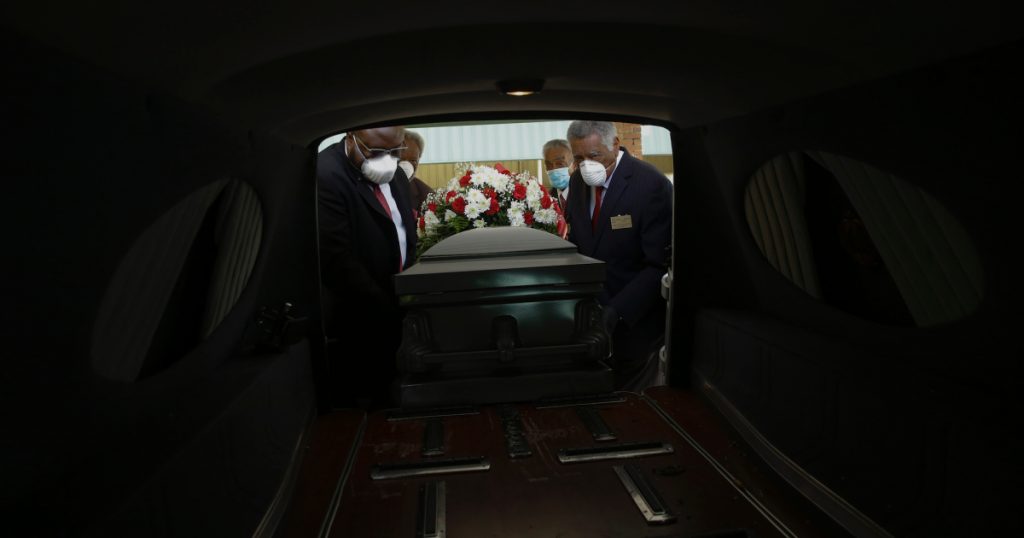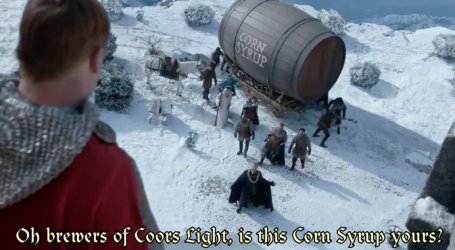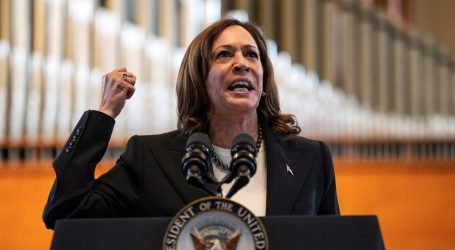The Coronavirus Has a Disparate Impact on Black Grief, Too
Mortician Cordarial O. Holloway, foreground left, funeral director Robert L. Albritten, foreground right, and funeral attendants Eddie Keith, background left, and Ronald Costello place a casket into a hearse on April 18, 2020, in Dawson, Ga. AP Photo/Brynn Anderson
For indispensable reporting on the coronavirus crisis and more, subscribe to Mother Jones’ newsletters.As of Wednesday afternoon, the United States as an official matter had lost 100,000 people to the coronavirus—100,000 people who are irreplaceable to someone else. This threshold was crossed without the large-scale acts of public mourning with which we typically observe mass death. The closest thing to it was the sobering front page of Sunday’s New York Times, which listed the names of 1,000 people who’d died of COVID-19 in the United States.
Earlier this week I called up Dr. Kami Fletcher, wondering if and how Americans were processing so much death in their midst. Fletcher is a historian at Albright College, co-author of Till Death Do Us Part: American Ethnic Cemeteries as Borders Uncrossed, and president of The Collective for Radical Death Studies, which works “to analyze how death, mourning, burial, and death investigations have changed over time along the lines of race, class, gender, ability/disability, sexuality.” Her work centers on the ways that asymmetries in life persist in death—a subject particularly relevant to a disease that has taken a heavy toll on Black and Latinx people.
Fletcher and I spoke about the “death-denial culture” in the United States, the disruptions caused by the coronavirus to Black death rituals, and how the country would be mourning today if the pandemic were disproportionately killing white people. Our conversation has been edited for clarity.
I wanted to start by asking about the cover of the New York Times over the weekend. I’m curious to hear what was going through your mind when you saw that.
A good historian friend of mine shared a similar thing from the Spanish flu of 1918, and looking at the New York Times front page, it brings humanity to it. These were people, these were living, breathing people. They were part of our educational system, our job network here. These were Americans. These were people who have left behind family members who are mourning, who are grieving, and who have unanswered questions. Let’s start having a real human connection to this.
I’ve been thinking about the idea of not being physically together at a time of mourning. We can’t get on a plane or a bus or a train, and travel to be with our families after a loss. We can’t console each other. That physical distance adds to the anxiety that builds up when you’re cooped up at home, knowing something has happened and you can’t be there. What does that do to how we process death?
We’re in a death-denial culture, as Americans—we deny death. That’s really the prevailing idea. We put death in a hospital, we put death in a hospice, and we try to have a quick funeral, and it’s private. We try our best to deal with it and go on. Which is the complete opposite of what Black folks have been doing. Black people and people of color who have been dealing with white supremacy, with racism, and with the legacy of direct colonial rule have had to adjust and adapt. And it shows in our mourning customs.
I just want to make a point here. There was a 7-year-old girl [Jakelin Caal Maquin from Guatemala] who died two years ago [in Border Patrol custody] and while unfortunately it’s not an irregular story, it made news. And I remember posting that on Twitter and saying that whatever mourning rituals were happening were to try to explain why the 7-year-old girl is not here anymore. That’s what death rituals do. That’s what mourning is about. And right now, we cannot group, we cannot sit with the bereaved.
There’s no way that we can talk about deaths from the coronavirus and not talk about race. People of color are being hit particularly hard by the virus. As a Mexican immigrant, I think about how this affects my community. So how does the African American community grieve right now? Is there collective grieving within a community when it’s so hard to grieve in general?
The color of COVID is Black and Brown, I think it’s very clear. Every person that has died of COVID in Richmond, Virginia, was Black [as of mid-April]. We’re also talking about Native Americans—the Indigenous population in certain areas of the country are just being decimated. And some of the reasons why are just bureaucracy. They literally cannot get the funding to the groups of people.
Which goes back to your question about why we are not public mourning. It’s because of the mentality of “Black and Brown people just kind of brought it on themselves.” That’s why you cannot talk about death if you’re not talking about culture and history. I’m not even taking into account the different religions or atheists—when I talk about Black folks, I’m talking about this collective Black experience born out of slavery and oppression. So are our funerals going to be three or four hours? Absolutely. Absolutely. Because to mainstream society we’re just a number: “Oh a bunch of Black people died, they had high blood pressure already, they smoked a lot, they drank a lot.” There’s no care. There’s no concern there.
But at the funeral, that was somebody’s daughter. That was somebody’s mother. She actually served as the president of the PTA. She actually developed a type of Meals on Wheels program for the elderly in her community. At the funeral, you get this three-dimensional, non-stereotypical image of Black folks in our last-rites rituals. And that’s very important. It’s communal, and COVID has definitely disrupted that.
At the risk of asking the very obvious, what would our collective mourning as a country look like if the faces of those who died were not mostly people of color? If this had been something that really hit white rural America hard? Would we, as a country, our elected officials and our news media, be talking about these deaths differently?
I really am glad that you asked that because I think that lends itself to part of the conversation that we think we know, but maybe we don’t. And we need to have a conversation about it. I think when you’re talking about African Americans specifically in this country, there is a connection to violence and death that people have taken for granted and are okay with. People really think that Black bodies are disposable. White people are authority figures. That’s what white supremacy sets up.
We can draw similarities with heroin and crack. When crack hit Black America, it was about Black people smoking crack and killing each other. But when the heroin epidemic started, it was about opening up centers to help these people. I think everybody should be helped—I don’t want anybody to hear this and think otherwise. Everybody needs to be helped. But it’s been racialized.
I keep hearing stories, reading reports, and seeing in social media that Black people are going to the hospital during this time period and not being believed. They’re being turned away and mistreated. That’s what we’re dying of. And that has to be part of the discussion. You’ve had medical professionals not believing that Black women are in pain, dying in childbirth. I don’t know if people really understand how much they lead with stereotypes.
It seems that—at least for me—that in the beginning of all of this we were hearing more about the dead: a profile of a family, a group of friends at a nursing home, the story of multiple relatives who died from COVID-19. As the numbers kept multiplying, we went to tens of thousands. Do we process that slow day-by-day death count differently than, let’s say, a plane crash or mass shooting or natural disaster that kills many people at once? Is there a difference in how we process this loss?
The first thing is the idea of death and disaster: A hurricane that we cannot control has killed people, or a bomb has been dropped in a war. Is it a difference in how we mourn? I think you have to look at who’s controlling the conversation. When you have a conversation where the surgeon general is saying, ‘These folks are bringing it on themselves, you know, lay off the tobacco, lay off the alcohol,” I definitely think you lose empathy. And there’s distractions going on. I never would have thought—but I guess as a historian I should have known—that these “liberate the state” rallies would pop up. I literally walked out of my house three days ago going to the post office that’s a block from my house and the local courthouse, and I was just shocked and really alarmed and fearful of a “liberate the state” rally. You can’t have people mourning and grieving and feeling sad if you honestly are saying, “No, no, nothing’s really happening here, I’m willing to die of COVID for the economy, let’s sacrifice the elderly.” This is disrupting the kind of national mourning that we should be having when 100,000 Americans are dying.
At the Collective for Radical Death Studies, we’re creating this type of library, this mini-documentary, because it’s so easy for the stories to get lost because they’re people of color. So send us your pictures, a brief synopsis saying this is who this person was in your community, and tell us what is happening.
That closeness that we talked about earlier—I can’t even imagine not being physical in a time of loss, as a Latina, the hugging, kissing, handholding, sitting side by side with someone is so important for us. This makes me think of the public vigils after mass shootings. I’ve been to a few, unfortunately, as a reporter—most recently the one in El Paso where so many Mexican people were killed—and there’s something to be said for having physical space to bring a balloon or a sign, even if you didn’t know anybody who died, just to sit there with a physical representation of death and loss. Those are things we can’t have right now. Do you think something like the New York Times front page shook that back into the conversation a little?
Yeah, I love that “shook that back into the conversation,” because what do you do if you’re trying to flatten the curve? Right now we can’t do a memorial, we can’t take a balloon anywhere. When you look at how African Americans and Latino culture have used the “Rest in Peace” T-shirt, I think that can be a powerful memorial.
Once again this is one of those things that’s been misunderstood because you have this dead person on a T-shirt and you’re walking around with it. People associate it with gang-related activity. So again that’s that kind of deviant, at least what sociologists call “deviant”—not as in devilish, but as in outside mainstream culture. It is a way to memorialize someone by socially distancing too, because what we’re really saying is that these people existed. They lived, they were here, and that’s why you have something like the ghost bike where a cyclist has died. It’s bolted down in a certain place to say this person mattered, something happened here, and we need to address it.





